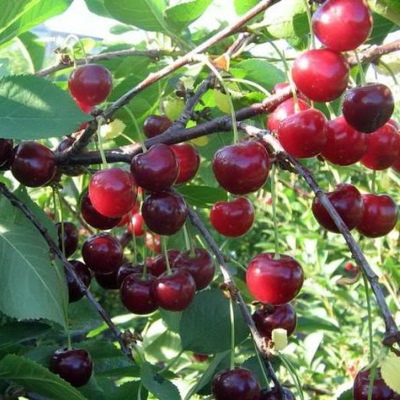
- Authors: N.I. Gvozdyukova, S.V. Zhukov
- Year of approval: 1959
- Barrel type: bush
- Growth type: undersized
- Crown: wide, raised
- Foliage: medium
- Leaves: elongated obovate, dark green, shiny
- Flowering and fruiting type: on bouquet branches and annual growth
- Fruit size: below the average
- Fruit size, mm: 17x18x17
Variety Shchedraya is one of the most famous varieties of bush cherries. Winter-hardy and drought-resistant, it is grown throughout Russia. Berries are consumed fresh, used for canning, making stewed fruit and jam. Suitable for garden and industrial cultivation.
Breeding history
The subspecies was created by breeders NI Gvozdyukova, SV Zhukov on the basis of the Sverdlovsk selection station of gardening as a result of free pollination of the hybrid form Ideal. Included in the register in 1959.
Description of the variety
The variety is low-growing, up to 2 m high, the crown is wide and raised, the foliage is medium, the branches are spreading. Leaves are oblong-obovate, with a curved leaf blade, finely serrated, dark green, shiny. Flowers are white, 2 cm in diameter, collected in inflorescences of 3-4. The variety blooms in the 20th of May. Resistant to spring frost. The tree has a lifespan of over 30 years.
Fruit characteristics
Cherries are medium-sized, weighing 3-4 g, rounded, dark scarlet, juicy and dense flesh, small stone, detachable. The skin is glossy, usually does not crack. They have an attractive appearance. The fruits collected with stalks are stored for about 3 weeks in a cool dark place at a temperature of +4 and a humidity of 80%. They tolerate transportation well.
Taste qualities
Table taste, sourish, with an intense aroma. Sugar content - 6.7%, fruit acids - 1.5%, ascorbic acid - 13.2 mg / 100 g. Tasting score - 4.4 points.
Ripening and fruiting
Begins to bear fruit 3-4 years after planting, then regularly. The variety is considered late in terms of ripening: the harvest ripens in the second half of August or early September. Ripening is not close, overripe berries do not crumble.

Yield
About 13-17 kg are removed from one tree.
Growing regions
Suitable for growing throughout Russia.
Self-fertility and the need for pollinators
The variety is partly self-fertile. To obtain a good harvest, planting of pollinating varieties is required: Maksimovskaya, Subbotinskaya, Standard of the Urals, Polevka, Mayak. To achieve the desired effect, these species should grow at a distance of no more than 35-40 m.
Landing
The soil is prepared in the fall: it is dug up and lime is added. A month later, watered with fertilizers: 1 sq. m A landing pit with a diameter of 40 cm and a depth of 50 is prepared in advance. They choose a bright place, protected from the north side from the wind, preferably on an elevation. The plant does not tolerate the abundance of moisture in the soil: this can damage the roots.
Plants are planted in the spring. Drainage is laid at the bottom of the hole, organic compounds and sand are added to the soil.After planting, a round groove is built around the tree for irrigation, about 4 buckets of water are poured, and mulched. The young plant is watered as the soil dries up 3-4 liters at a time.


Growing and care
The described variety is considered unpretentious in care and drought-resistant. The lack of moisture affects the quality of the crop: the fruits will be small and dry. Adult cherries are watered abundantly, but infrequently, about 3 times per season. The first time they irrigate after the end of flowering, 2 - during the ripening of the fruits, and in October they carry out a water-charging 3 watering. About 5 buckets of water are poured out at a time. In dry weather, they are irrigated more often.
Feeding begins at the age of 3 years. After the snow melts, nitrogen fertilizers are used, in the fall - potassium sulfate and superphosphate. They are fed with organic compounds 1 time in 2 years, liming of the soil is carried out every 5 years.
The tree needs formative and sanitary pruning, which is carried out annually after the buds have awakened. A fully formed crown of a five-year-old plant should have 10-15 strong skeletal branches. Then only thinning pruning is carried out. Annual shoots of fruiting trees are not pruned.


Disease and pest resistance
The variety has good immunity to the main diseases of the culture, including clotterosporia. Average resistance to coccomycosis and moniliosis. Weakly affected by mucous sawfly and aphids. For prophylaxis in the spring when the buds appear, and then after the end of flowering, they are treated with an aqueous solution of copper oxychloride, after harvesting, they are sprayed with Bordeaux 1% liquid.
Requirements for soil and climatic conditions
The drought-resistant cherry species easily tolerates a dry climate with high temperatures in summer. It is able to withstand frosts down to -45 degrees, it is distinguished by high winter hardiness of wood and buds. Strong cold wind and icing of the crown are most dangerous for the plant. In the northern regions, it is recommended to bend it down for the winter and fix it in this position, closing it on top with a spunbond. The variety is undemanding to the ground. The best option is sandy loam soils of neutral acidity.

Review overview
Cherry pleases gardeners with a generous harvest for many years, and often the tree planted by parents goes to children. Not everyone likes that the cherry ripens in several waves. The variety suits many with good yield and unpretentiousness. Gardeners replace old bushes with young ones and continue to grow this variety.































































